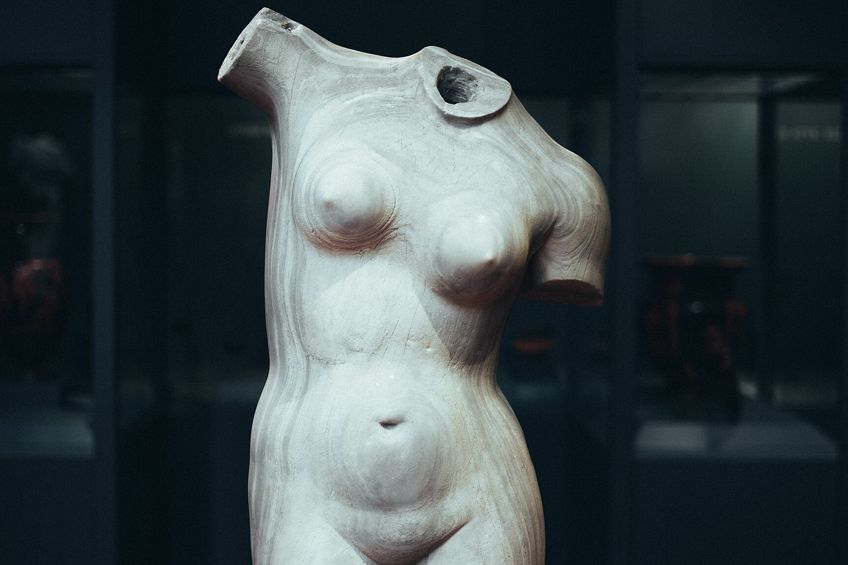Classical Art – The Lasting Impact of Greek and Roman Art
The Classical Period began in Ancient Greece from the 4th to 5th centuries BC, ending with the fall of the Roman Empire. When it was rediscovered, classicism-period art, which includes Ancient Greek art and architecture made such an impression that it came to be known as Classical art. Indeed, the very field of art history is founded on the study of the art of ancient Greece.
Contents
What Is Classical Art?
Classicism is a definition that is used to describe art that emerged during the Italian Renaissance. Classicism art usually refers to a revival of ancient Greco-Roman traditions. The Renaissance occurred around the 15th and 16th centuries AD in and around Italy, and the term renaissance means “rebirth”. Classicist Art often refers to a period that lasted over a thousand years, encompassing Greek and Roman Greco-Roman Sculptures of ancient Greece and Rome (c. 650 BC-400 BC). Classical Art came out of the ancient period when European culture and specifically the Mediterranean was dominated by Greece and subsequently Rome. The rise of rational philosophies meant the Greeks were interested in astronomy, moral issues, ethics, and naturalism. These explorations are expressed in ancient Greco-Roman art.
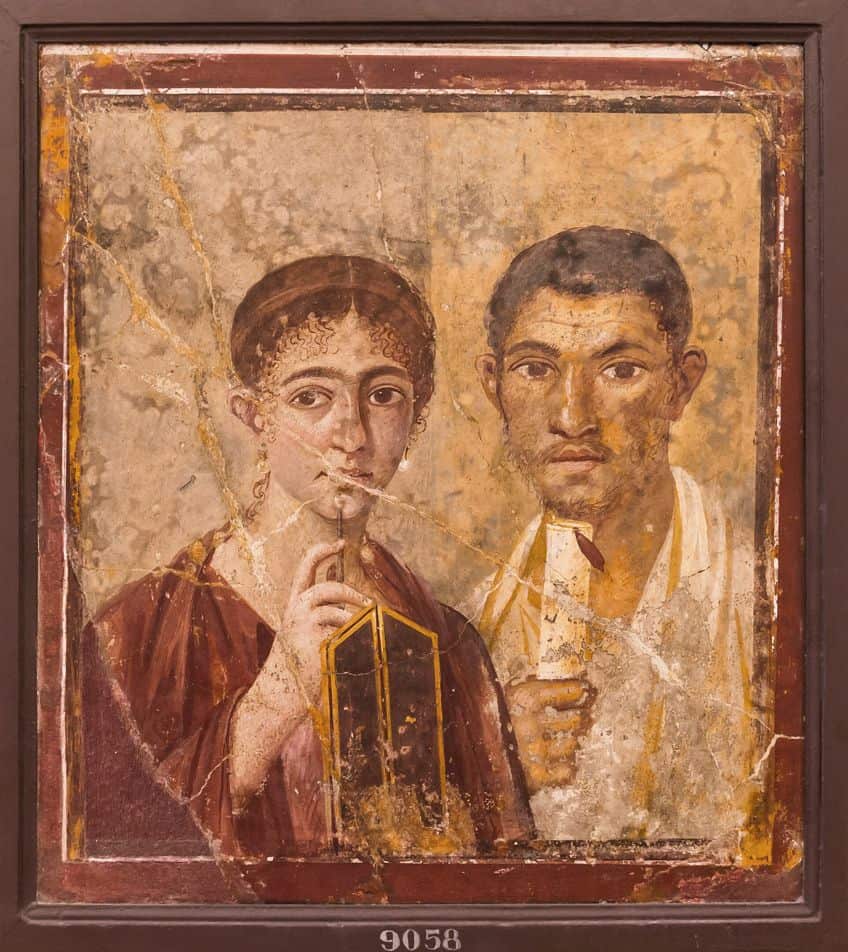
There are four main categorizations of ancient Greek Art: the Geometric period, the Archaic period, the Classical Period, and the Hellenistic Period. These were then followed by the Roman Period, which was something of a revival. Classical and Classicalism art can then have varying definitions depending on the context, and can be applied to architecture, sculpture, painting, literature, music, or philosophy. Aesthetically, the term “classical” implies simplicity, clarity, symmetry, and elegance. Thus, Classicalism art could imply restraint, formality, and adherence to academic rules and ideals.
What Is Classicism?
Classicism art refers to artworks made according to Classical Greco-Roman academic traditions. Rebirths of the Classical Greco-Roman are numerous throughout art history and are characterized by formal academic principles. The Renaissance and other Classicalism revivals are often associated with humanism, naturalism, idealism, and divergence from religious doctrine. Humanism values are consistent with those of the ancient Greeks. This is why there is a focus on human anatomy in Classicalism sculpture and painting.
These figures often have ideal proportions, or to ancient Greco-Roman stories, philosophers, or Gods.
The Classicism-Period Art Timeline
In order to understand the various art periods of Classicism-period art, it is important to understand the context in which these movements occurred. Greek history has been surveyed and studied extensively, so below, we have presented a brief overview of the sequence of events that led to Classicism-period art.
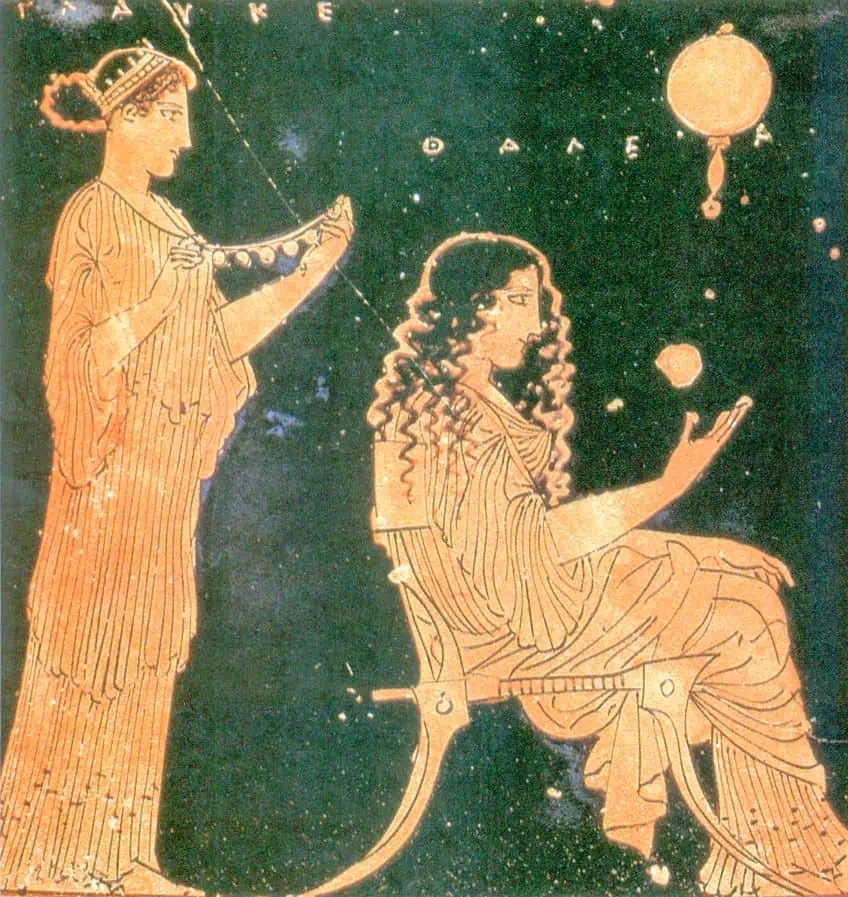
The Golden Age: Classic Antiquity (c. 800 BC – 410 AD)
The age of classical antiquity is the original age of Classicism that took place in the ancient Greco-Roman world, from around the 4th to 5th century BC in Ancient Greece to around the fall of the Roman Empire around the 4th to 5th century AD. During this period, there was an explosion in literature, theatre, and philosophy. Great Greek philosophers, poets, dramatists, and playwrights like Socrates, Plato, Aristotle, Sophocles, and Aristophanes were at work. The law of Draco was published in 621 BC, initiating the Athenian move toward the world’s first democratic government.
In the same period, Greece lived in volatility with numerous city-states.
The two powerful city-states Sparta and Athens often clashed, wrestling for power. But Athens and Sparta worked together once the Persians attacked in 480 BC and they fended the invaders off, though the city of Athens was left badly damaged. Athenians needed to rebuild. Greek civilization and society were still surging with confidence after they triumphed over the Persian Empire, and this launched the Golden Age or the Classical Period. By this stage, Athens had gained dominance over Greece and the Athenian influence would lead to what we call ancient Greek Art today. In about 450 BC, Athenian general Pericles embarked on a political campaign. To win the public’s support, Pericles commissioned art, temples, and buildings all over Athens. As part of his campaign, Pericles commissioned the Parthenon, a temple dedicated to the founding goddess of Athens – Athena.
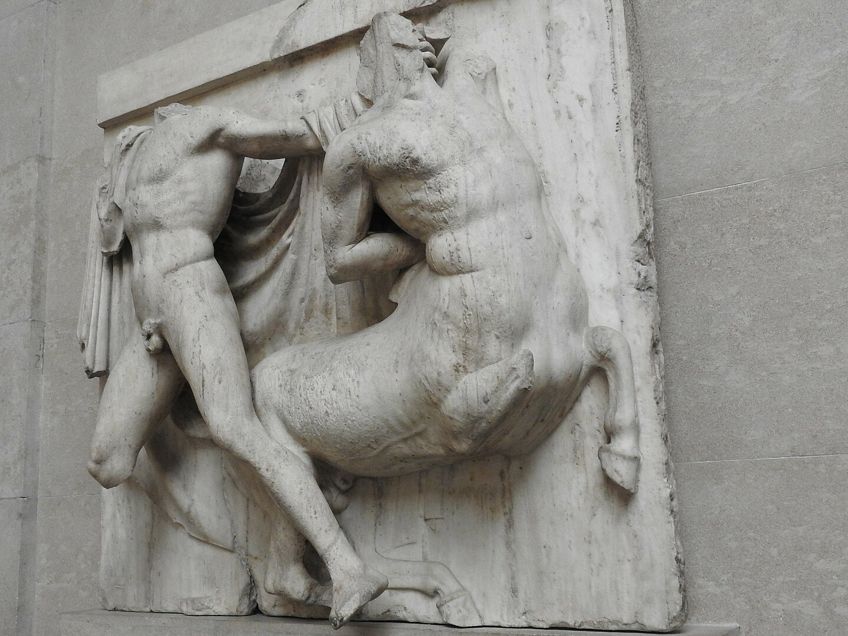
Some of the most famous iterations of Classical Greek art and culture were created for the Parthenon. It was decorated by the famous sculptor Phidias. The Parthenon housed Athena’s legendary Gold and Ivory Statue among other important examples of Classical sculptures. The architecture of the Parthenon influenced the art of the 5th century BC and beyond. The Parthenon features ground-breaking architecture with friezes carved in relief incorporated into the temple design. The frieze sculptures, such as the Horsemen from the west frieze of the Parthenon (c. 438 – 432 BC), illustrate mythological or historical scenes, animals, musicians, weavers, elders, soldiers, heroes, or gods.
The Greek Canon
The Archaic period preceded the Classic period and produced standing figures like the Kouros (c. 500 BC) which were simplified figures, standing in a rigid posture where the weight is distributed equally on both feet. Eventually, artists figured out how to make statues stand upright without having their feet in such an unnatural position. In the Archaic period, it was rare for the artist who made any of the statues to be well known. This changed towards the Classical period, when artists begin to become famous for their skills. In the 5th century, at the high point of Classicism sculpture, The Greek Canon emerged. This period represents a fruitful era for Greek culture a and dramatic shift in the design of statues.
With the advent of rational philosophy, Greek culture had begun pushing the boundaries of human knowledge and gaining confidence in the human capacity to comprehend nature. This gave rise to naturalistic art.
Because of this interest in human knowledge and observations of the world, ancient Greek artists leaped into a new way of observing the body. Around the 5th century BC, ancient Greeks developed an interest in portraying the human body in the most naturalistic and lifelike way. They developed the Greek Canon which is a system of artistic conventions for depicting the human figure. Because of these conventions, ancient Greek sculptures became more realistic while simultaneously becoming more idealistic. Classicism-period art started to portray the human body in what they believed to be the most ideally beautiful way this brought up notions of what made a person ideal and the proportions varied from artist to artist. The ideal body in the Greek canon was typified by youthfulness, athleticism, and symmetry. Greek artists used proportional anatomy, particularly the ratio of the size of the head to the body.
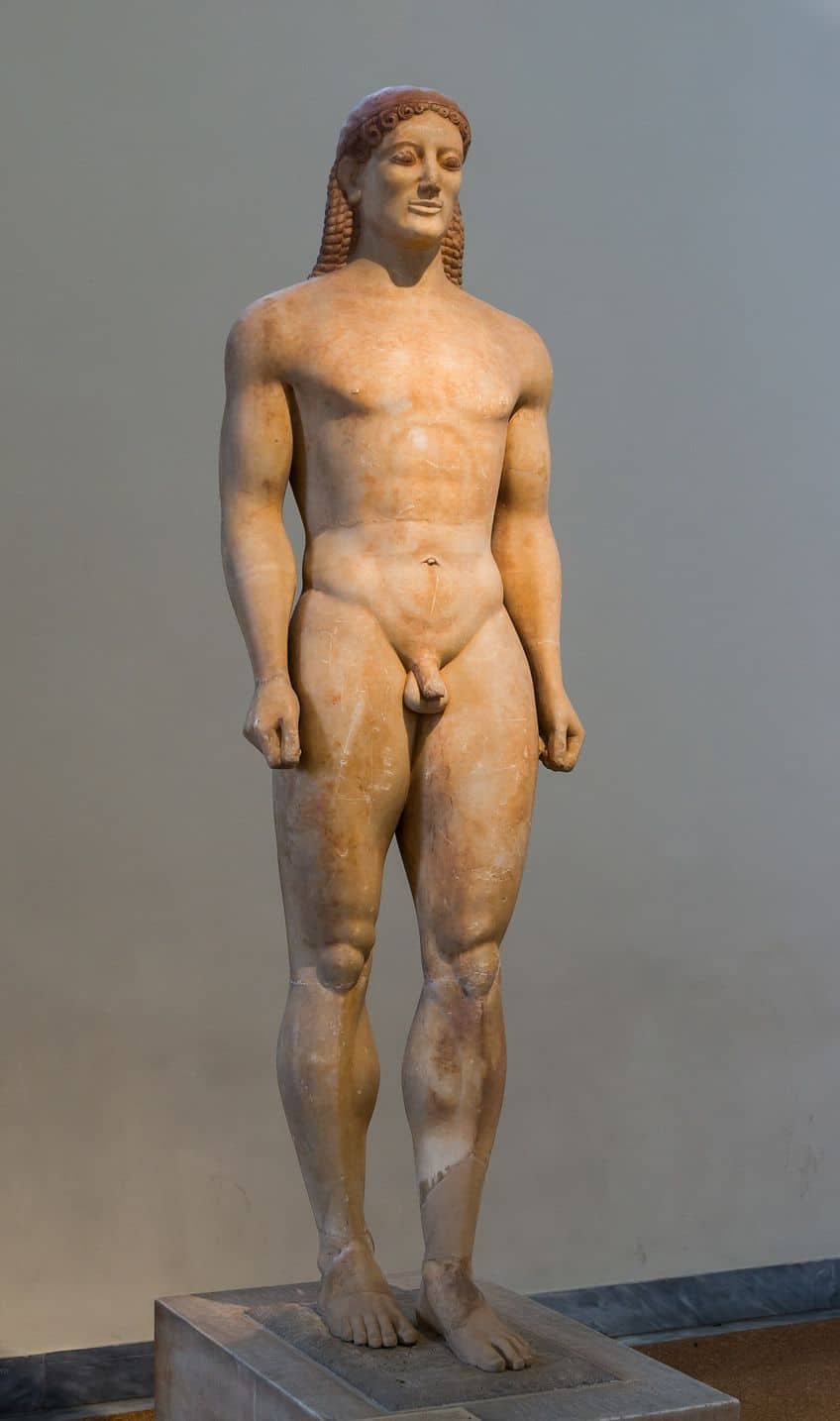
They deciphered that the average person has a proportional height of six and a half to seven heads. Eventually, they designed their own perfect ratio. The most idealized physique for the Greeks was eight heads high. Classical sculptures often depict well-defined muscles in great detail. Using principles such as contrapposto, they embodied more elegant, natural, and relaxed poses than in previous eras. As it aims to highlight these effects, Classicism sculpture tends toward the nude figure. Ancient Greek sculpture often almost always portrayed heroic, nude, young men such as athletes, warriors, or gods. Youth and masculinity were the height of idealism for the ancient Greeks. Even when older bodies were portrayed, they were ageless, bearded gods with older heads with bodies of the idealized youth, not to mention the minimal focus on the female form.
Polykleitos
What sets the Classical Period apart is that sculptors began to prioritize observation of the body in their attempts to represent it naturalistically. In Classicism sculpture, one of the first iconic western sculptors was Polykleitos. Polykleitos championed the mathematically ideal proportions of the human figure. Polykleitos figures were typically muscular and broad. He originally sculpted Doryphoros or Spear-Bearer (450-440 BC) in bronze, though today it can be seen only through its roman marble copy. Doryphoros’ hand is up because it would have held a spear which is now missing. The proportions of Doryphoros may be ideal, but the composition is asymmetrical. The figure naturally looks to the right and stands as if he’s about to step forward.
There is both a balanced orientation of limbs and a balance between dynamic and relaxed muscles.
Doryphoros displays an interest in how the mechanics of the human body. The distribution of weight, the contours of its muscles, and an understanding of the bones beneath the flesh. This sculpture is one of the best examples of the high classical posture called contrapposto. The figure stands with one foot forward and one foot back. The weight-bearing left leg is raised and the hip juts upward. This posture causes the axis line of the hip to be parallel to the axis line right through the ankles and in opposition to that of the knees. This compresses the other side of his body, making it look shorter, and letting the hip sag, expanding and extending the side where the free leg is. The figure of Doryphoros combines naturalistic or realistic and idealized elements. A classical nude figure with his head tilted off to the side. The naturalistic, lifelike marble sculpture shows us that the Doryphoros is based on careful observation. That the artist was looking at a real human figure and had a complex understanding of the human body.

Lysippus
Lysippus was an innovative ancient Greek sculptor who preferred more attenuated, lighter, and longer proportions. His famous sculpture Weary Heracles (c. 350-325 BC) depicts a muscular figure according to his version of the proportions of the Greek Canon. In Greek mythology, Heracles was the strongest man who ever lived. Lysippus’ sculpture depicts an older Heracles, his small head to the side, while the veins on his torso bulge, and his weight-bearing leg jutting to the right, causing a dramatic “S” curve to his body.
Most previous sculptures such as Praxiteles’ Aphrodite of Knidos were intended to be viewed mainly from one side.
Lysippus noticed that the power of a sculpture is that it can be seen from many angles. He selected a subject matter that compelled the viewer to move around the statue. Apoxyomenos (c. 350 BC) which can be translated to “the scraper”, could be seen as a typical sculpture for the time, considering it is yet another athlete in contrapposto. The male figure is seen scraping himself. This was a common practice performed by ancient Greek athletes after exercise. To see the action, a viewer would have to move around the sculpture, engaging with it in three-dimensional space.

Myron
Another great Greek Classicism artist from the middle of the 5th century is Myron who was well renowned for his sculptures of athletes. His sculptures were incredibly detailed, with great emphasis on posture. Usually, his figures are asymmetrical turning their head, and their feet moving one way or another. Myron’s dynamic sculptures appear frozen in time. It is as if they had been in the middle of some activity when the image was captured.
Myron displays a calculated naturalism in his marvel of composition Discobolus (c. 450 BC), which means the discus thrower. His figure is captured in such a way that at any moment you could see him move or turn.
Antikythera Youth (340-330 BC) is a rare sculpture in that the Greek original has survived. Though it is heavily corroded, it shows incredible evidence of Myron’s skill and mastery. Shockingly, the figure’s eyes are still intact, giving it an uncanny, lifelike quality. The sculpture was likely made as a monument to a famous athlete of some kind. The slightly tussled hair looks as if the youth has just come from an athletic match, conveying the ancient Greek ideals of youth and vitality. His hands are outstretched meaning he was either holding a ball or a vase. It was typical for small vases to be handed out as awards in athletic competitions. While this is sometime later, the figure still has Polykleitos’ sense of proportion. He has a strongly defined Adonis belt, obliques, a broad chest, and a relatively small head.

Praxiteles
By the 4th century, Athens had begun its long decline. It was no longer the capital city. Major cities had succumbed to the rising power of Phillip II of Macedon, and eventually Alexander the Great. As a result, there were some changes in sculpture. The new crop of artists began experimenting with the form. They were no longer constraining their figures with those massive proportions. The new ideal was a less defined anatomy that was more concerned with the elegance of the figure. Known for his light, lyrical compositions, the Classicism artist Praxiteles’ rose to fame and distinguished this period. Praxiteles was commissioned to create the Aphrodite of Knidos (c. 340 BC) for a sanctuary in Knidos dedicated to Aphrodite.
Knidos was a city on the far end of the peninsula of what is now the Turkish coast.
Until that point in Classicism-period art, females had been clothed and there had been no female nude statues. The ancients had preferred to preserve the modesty of their female figures. Instead, ancient Greek artists had experimented with the drapery, making it look wet, clinging it to the body to reveal its form. Praxiteles broke that tradition and began the shift into the monumental tradition of female nudes. Aphrodite of Knidos became the first nude sculpture in ancient Greek art of the Classical Period. The sculptor must have sensed that it would be appropriate that the goddess of love and sensuality to be the first female to be portrayed in the nude. In Greek mythology, Aphrodite is also the goddess of the sea and was known to perform ritual baths in the sea. Therefore the mythology around her was the ideal justification for depicting her as a Classical nude figure.
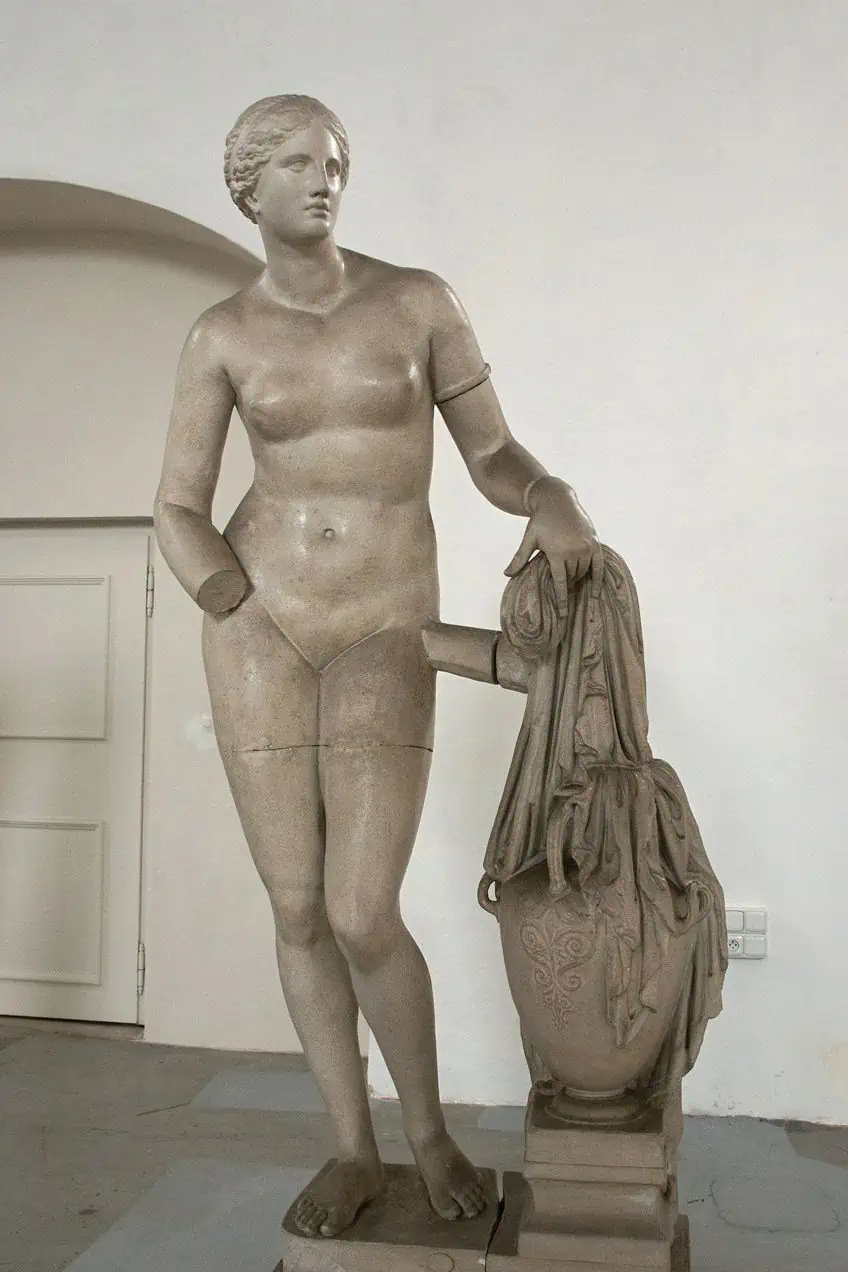
Although it is idealized, Praxiteles’ Aphrodite is naturalistic in both form and character. In a façade of modesty, Aphrodite covers her nether regions, simultaneously directing our attention toward them. Her contrapposto posture makes her seem both relaxed and dynamic. Aphrodite of Knidos was an influential and innovative sculpture and it helped canonize contrapposto. Once again, there are very few Greek originals, so we only know this work through Roman copies. More roman copies were made of Aphrodite of Knidos than of any other Greek sculpture. Because of the wide variation of copies that exist, we only have a sense of how the original would have appeared.
Hellenistic Period
In the 4th century BC, Athens had long begun its decline. However, Alexander the Great’s patronage of the arts spread the Classical Greek style causing it to substantially influence the indigenous forms and styles of neighboring cultures. Decades of fighting had taken their toll on Athens and it had lost its power as a political capital, but its artistic prowess remained. Around the 4th century BC. amid the constant threat of war, Greek artists continued to develop new styles and techniques.
Eventually, artistic vocation and artistic formal education were established.
In the latter period of Classicism-period art, the Hellenistic age, the incredibly lifelike sculptures incorporated more action, emotion, and unflattering features. Although the sculptures retained their idealized symmetry and proportions, Hellenistic art was increasingly repurposed as propaganda. Two sculptures that exemplify the Greek idealized style of the Hellenistic period are Venus de Milo (150 – 125 BC) by Alexandros of Antioch, which has lost its arms over time, and Winged Victory of Samathreus (c. 200 – 190 BC) supposedly by Pythocritos, son of Timocharis of Rhodes, which portrays the goddess Nike in a dynamic posture, about to take flight.

Roman Art (500 BC – 476 AD)
The Classical period is characterized by classicist artists developing ways of creating more realistic images. Roman art simply takes this a step further. Roman recreations of the human form have more expressive faces than in the original Greek Classical period. The Romans were inspired by Greek culture and they took control of Greece in 214 BC. They copied Greek art, and architecture, and even adopted and renamed Greek gods. Roman architects enthusiastically embraced the Classical arch and the dome. The introduction of the arch was a big innovation for the building of bridges and aqueducts. The dome became the staple of official buildings such as the Pantheon, an influential icon of Western architecture.
However, when it came to their art, the Romans were more inclined to portray real people. Rather than conjure an ideal physique, Roman Classicism artists aimed for a more accurate likeness of the subject.
Romans still used art as propaganda, glorifying emperors and promoting political agendas. Even though he was quite old at the time of the sculpture’s commission, Emperor Augustus had himself portrayed as a young, strong military leader in his warrior’s breastplate. Just like Polykleitos’ Doryphoros which is a Roman copy from Naples, many of the images referred to in the subject of ancient Greek art are Roman copies of Greek sculptures. The sheer volume of Italian copies illustrates the extent to which the Romans were inspired by ancient Greek sculpture.
Though they occasionally worked in marble, Greek originals tended to be sculpted in bronze which is freestanding and does not need any support structure or struts. Conversely, the Roman copies were made from marble, tree trunks, and other objects were used to support the figure. Marble was more brittle and less self-sustaining. As they were mass-produced, Roman copies are often considered inferior and not considered as highbrow as their Greek originals. Particularly in the 18th and 19th centuries, calling an artwork a “Roman copy” would be considered a great insult. The Romans were seen as mere copyists.
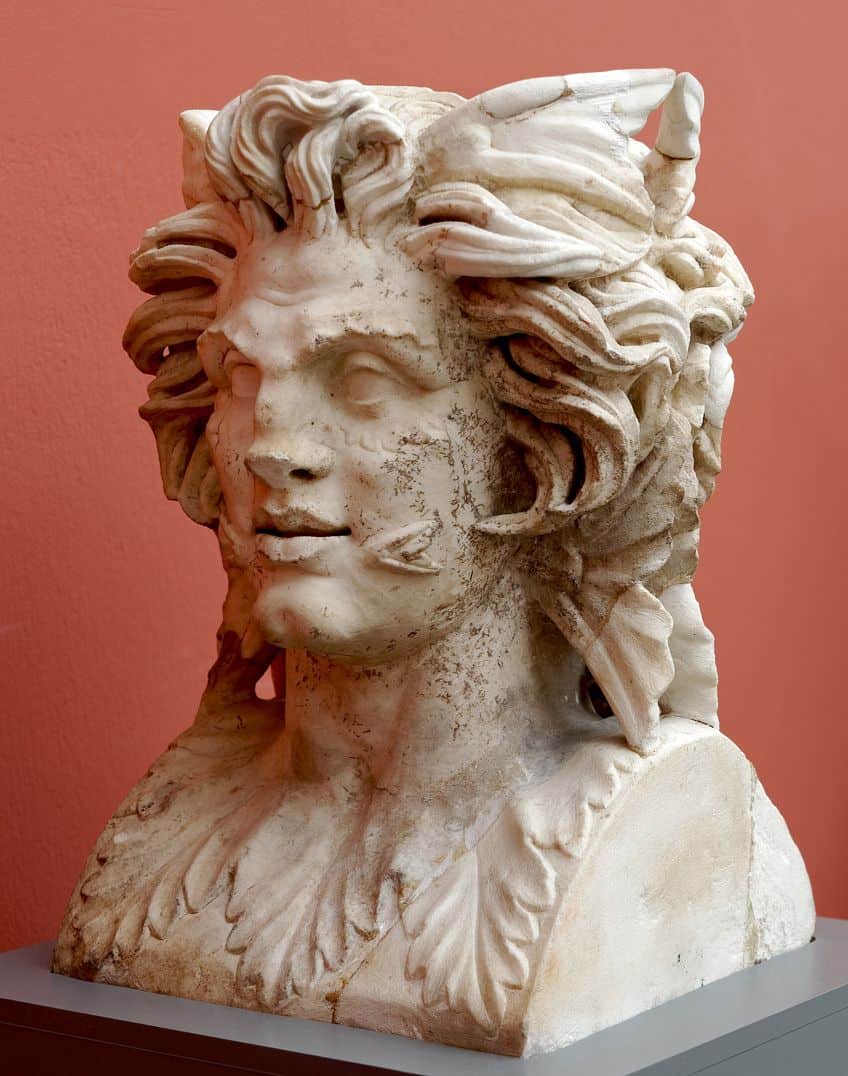
The Italian Renaissance (13th Century)
Around the first century BC, the Roman writer Vitruvius (ca. 80 – 15 BC) wrote his famous book Ten Books on Architecture, which as the name suggests, was mostly about architecture but Vitruvius also wrote about the ideal human proportions. Copies of this book survived though they didn’t gain wide circulation in Europe until the printing press was invented in the 15th century. As a result, another revival of Greco-Roman artistic styles took place around the 15th and 16 centuries. It was in the middle ages, that the purpose of art shifted away from naturalism or realism toward disseminating the gospel to the unwashed and mostly illiterate masses. For roughly a thousand years, ancient Greek artistic practices had not necessarily been forgotten but rather forgone for religious narrative.
Artists of the Middle Ages attempted to divert the gaze away from earth and towards heaven. Depicting nudity and muscular bodies could incite lust and sin.
The human figure in the Christian art of the dark ages was sculpted in relief, the figure would have been covered in drapery. The artists focused on the patterning of the drapery, attempting to enhance the figures’ otherworldliness, by making them appear to be floating. Centuries later, artists of the Italian Renaissance began looking back not to the middle ages but to ancient Greco-Roman art. Artists like Leonardo da Vinci attempted to recreate the proportions of the Greek ideal. One of Da Vinci’s most well-known images The Vitruvian Man (1490) is based on Vitruvius’ ideal proportions of a human body. though Da Vinci worked from a bad translation, making his proportions incorrect.
In Renaissance Florence, artists like Donatello, Michelangelo and Raphael created work that recalled the tremendous naturalism that the ancient Greeks and Romans had achieved. Artists of the Italian Renaissance saw themselves as the inheritors of the ancient Greco-Roman sculpture traditions. Meaning “rebirth”, renaissance is a French word that has come to define the rebirth of Ancient and Roman culture in the 15th and 16th centuries. It was through the Renaissance that we received the contrapposto pose as we know it today. There was a revived enthusiasm for Classical naturalism, the beauty of the human body, and its accurate rendering.

Careful observation of the material world came to the forefront once again. As a result, nudity sometimes even eroticism coalesces with the biblical narrative. The renaissance used biblical narratives alongside the focus and study of the human body. We refer to this revival of ancient Greco-Roman culture as Classicist art. Since the revival of the Italian Renaissance, the interest in Classicism art has never truly been extinguished.
Donatello’s David (1440)
Donatello’s David was the first-free-standing male nude since antiquity. It came 50 to 60 years before Michelangelo’s David. A viewer can easily walk around this sculpture, making it more naturalistic. Like Polykleitos’ Doryphoros, Donatello’s David has stripped off every item of clothing. It is all about the figure.
Donatello’s depiction of David is youthful in keeping with both ancient Greco-Roman tradition and the biblical story of David.
David stands in exaggerated, preening contrapposto, his hips jutting out, and all of his weight on his right leg. As David‘s left leg weightlessly and smugly rests on the head of Goliath, the sculpture portrays the moment after the slaying of Goliath. Donatello’s David (c. the 1440s) is an ideal embodiment of the principles of the Renaissance for rejecting how artists of the Gothic ages represented the human form.
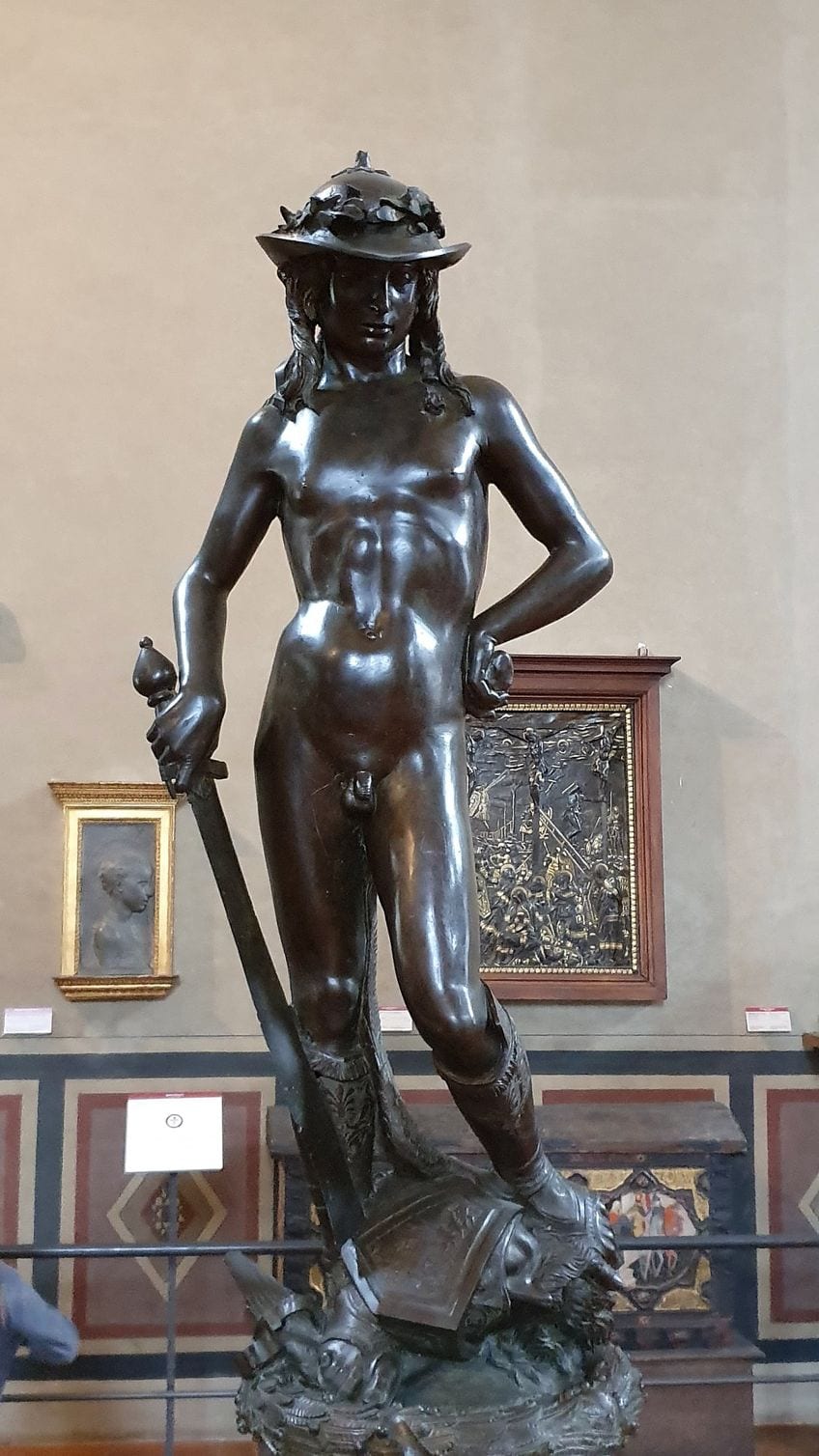
Michelangelo’s David (1501 – 1504)
Michelangelo’s David is one of the most recognizable artworks emerging from the Italian Renaissance. In art history, it is used to symbolize the transition from the Early to High Renaissance. This sculpture comes several decades after Donatello’s David. Michelangelo’s David is slightly older, with a more defined, muscular torso.
He seems more serious and his posture, while still in contrapposto, is less jaunty.
Michelangelo’s keenness for the human figure is evident in the elaborate detail of the hair, the veins, kneecaps, and the tendons in the hand. He is incredibly life-like but his colossal scale allows the viewer to get close, walk around, and see the delicate details. Though the figure does seem to be hanging the sling over his shoulder, the narrative references are almost completely stripped from Michelangelo’s David.
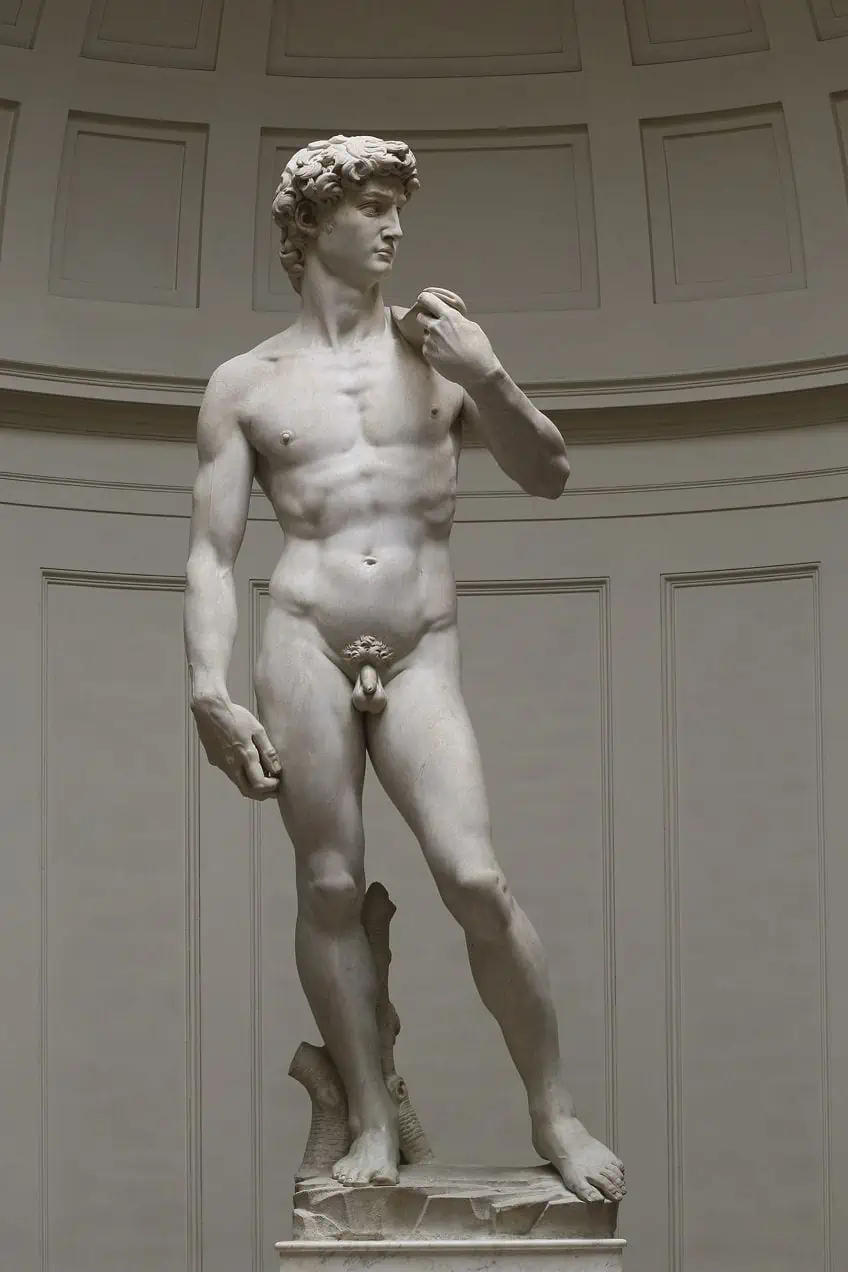
Neoclassicism (1760s – 1850s)
Around 79 AD, Mount Vesuvius, a volcano in the south of Italy erupted and buried its surrounding Roman cities including Herculaneum and Pompeii in 1709 and 1748, nearly 1,700 years later, these cities were rediscovered. Their excavations sparked renewed interest and curiosity in ancient Greco-Roman culture and resulting in Neoclassicism. The 18th-century rediscovery of the ancient Roman cities along with their art like the mural Pompeii Couple (1st century) made it popular for travelers, students, and scholars to tour the ancient cities and study their artifacts. This tour was known as the grand tour.
Neoclassicism took place in the 18th to 19th centuries and signified another revival of Classicist art. It occurred during the Age of Enlightenment. At this time, European countries were abandoning their monarchs, modeling themselves after Greco-Roman ideals of government such as democracy, veering towards individuality, scientific reasoning, and away from religious doctrine. Similarly to its previous iterations, Neoclassicism spilled over into architecture. Much of French and American architecture of the 18th century followed Greco-Roman ideals.
The Champs-Élysées (1670), Thomas Jefferson’s Monticello (1803), and Benjamin Henry Latrobe’s The White House (1817) are great examples.
This also happens to be the period of the origins of the study of art and the discipline of art history. Johann Winckelmann who was interested in ancient Greek and Roman art began creating stylistic categories, such as the Classical period and other terms we still use today. Identifying the Classical era as the most sophisticated, advanced, naturalistic period in art, Winckelmann (1768) claimed Classicism art as the standard of artistic perfection. Thus, principles of simplicity, harmony, and proportionality once again became preferable in most European art. Of course, this idealized gaze onto ancient Greco-Roman ideals was imperfect and by no means unbiased. For example, when Winckelmann wrote about the perfection of ancient sculptures, he re-imagined them as these perfect pure white marble figures.
The truth is that most Classicism sculpture would have been brightly painted, but the 18th, 19th and early 20th centuries imposed their aesthetics on these ancient objects. Subjugating them to their idea of an ideal figure. The sculptures were bleached to remove the color, though many have retained traces of color to this day, such as the Pediment Sculpture (c. 490-480 BC). Neoclassicism would have been quite a different movement had its proponents acknowledged the brightly colored nature of the art and architecture of the ancient Greco-Roman world. But the movement epitomizes the idea that idealism is not static.
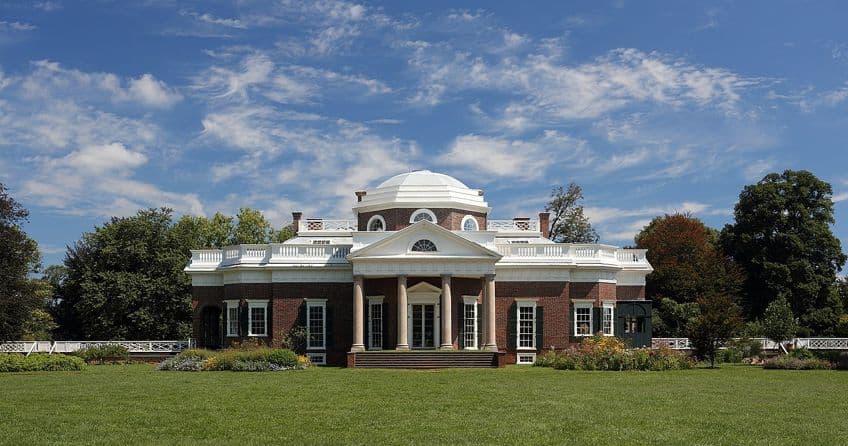
The Lasting Influence of Classicism-Period Art
Because these distinctions were made by art historians living in much later periods, it is important to recognize that referring specifically to Greek and Roman traditions as the height of formal academic principles in art, is of course a Eurocentric endeavor. The term is also generally quite broad. It encompasses roughly a thousand years of European history, revealing the limitations of our understanding of history. Large periods are jumbled together because the further back we search, the less we know.
By the 19th century, with industrial and scientific progress, the idea of a historic ideal had become less aspirational. Even in the 20th and 21st centuries, artists continue to grapple with this conflict.
As unrealistic as it has been, we have the Greeks to thank for setting the concept of ideal human proportions. Any random selection of human beings would reveal that we all have very different body types and ideals. So the ideals do not refer to the actual, but the ideal human figure. The expansion of the Roman Empire spread Greco-Roman motifs across Europe establishing the tenets of Western culture. Most things are influenced by ideas developed in ancient Greco-Roman culture and one of the most influential lessons from the ancient Greco-Roman world is its societal emphasis on the arts.
The Final Foundation
Classicist Greek art is the foundation of many contemporary art practices. Portrayals of the human form and techniques of sculpture and painting are still founded on these Classical traditions. This was a culture that cared about human potential and manifested art that naturalistically represented the ideal body. The Greeks were the first culture to make human figures who looked a lot like we do, but better.

As society moves forward, humanity continues to toil in the shadow of the ancient Greeks and Romans as this epitome of human excellence. A perfection that we can only hope to re-achieve. To this day, all kinds of artists, including comic book artists use proportions based on Greco-Roman ideals to draw their superheroes. There is an evergreen enthusiasm for Classicalism art and artists are continuously developing new ways to interpret and revive its traditions.
Frequently Asked Questions
Is the Classicism Definition the Same as the Classic One?
The Classicism definition is different from the word classic. The word classic refers more to classic cars or classic rock. Classic things are wonderful examples of a certain era. In art history, the term classic could refer to the Classic Maya Period (c. 250 AD – 900 AD), as this refers to a specific time period in the past, with recognizable aesthetics and cultural relevance.
Did Alexander the Great End the Classical Period?
The Classical period began after the Persian wars. Alexander the Great took control of Greece in 336 BC, spreading the Greek empire throughout the world. His reign lasted until the Macedonian conquests under Phillip of Macedon and his death ended the Classical period.
What Is Contrapposto?
The ancient Greeks discovered the pose known as contrapposto. Contrapposto was the result of careful observation of the way the body aligns when it rests on one leg. Through the use of contrapposto, ancient Greek sculptors became the first to create naturalistic images of the human figure.
What Is the Geometric Period?
The Geometric period spanned from 1000 to 700 BC. The period in Greek art was called this because of the decorations on the pottery at that time. Pots were decorated with basic geometric patterns and later, abstract figures of animals and people.
Liam Davis is an experienced art historian with demonstrated experience in the industry. After graduating from the Academy of Art History with a bachelor’s degree, Liam worked for many years as a copywriter for various art magazines and online art galleries. He also worked as an art curator for an art gallery in Illinois before working now as editor-in-chief for artfilemagazine.com. Liam’s passion is, aside from sculptures from the Roman and Greek periods, cave paintings, and neolithic art.
Learn more about Liam Davis and about us.
Cite this Article
Liam, Davis, “Classical Art – The Lasting Impact of Greek and Roman Art.” artfilemagazine – Your Online Art Source. September 26, 2023. URL: https://artfilemagazine.com/classical-art/
Davis, L. (2023, 26 September). Classical Art – The Lasting Impact of Greek and Roman Art. artfilemagazine – Your Online Art Source. https://artfilemagazine.com/classical-art/
Davis, Liam. “Classical Art – The Lasting Impact of Greek and Roman Art.” artfilemagazine – Your Online Art Source, September 26, 2023. https://artfilemagazine.com/classical-art/.


